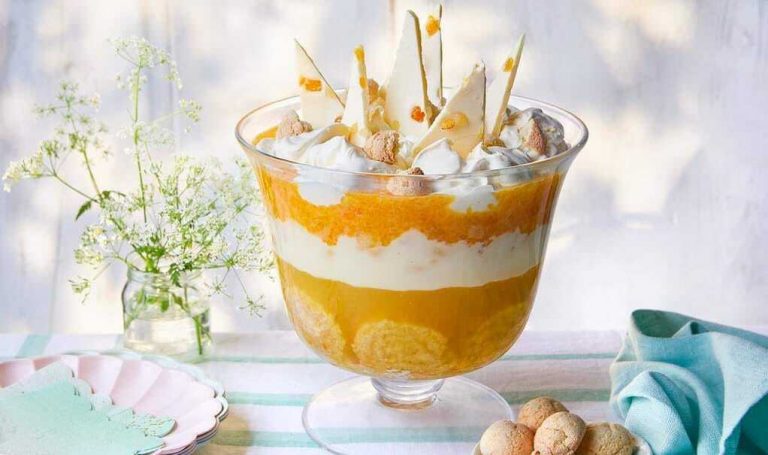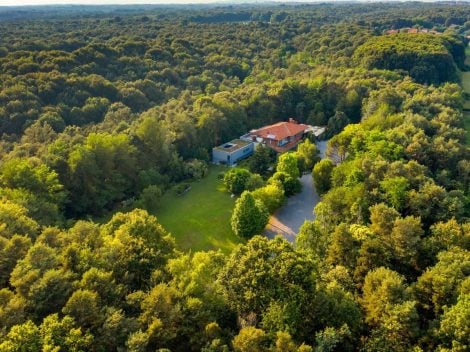The recipe book of the Platinum Jubilee
When Queen Elizabeth II came to the throne seventy years ago, the English gastronomic scene was quite bare. Many foods were still rationed and the small selection of ingredients was a major challenge for even the most creative cooks. The typical dishes of other countries were mostly unknown, olive oil was sold in small bottles mainly for medical use and street food par excellence was fish and chips. Today's times have changed, but the pleasure of sitting at the table and sharing a meal has remained the same as always: even during Royal visits, in fact, food plays a leading role. And so it will be during the celebrations of the Platinum Jubilee, which will begin next June 5 to last then throughout the month. On the occasion of the anniversary, Jon Croft Editions has published an official recipe book: The Platinum Jubilee Cookbook, which collects a series of recipes of British embassies and diplomats around the world, "some truly local, others proudly British, still others representing the combination of British and other influences, often with special effects," as commented by Charles, Prince of Wales, and Camilla, Duchess of Cornwall, who penned the preface.
Recipes from the embassies
Ameer Kotecha, diplomat at the service of the queen and gastronomic writer, who from 2018 to 2020 also managed a pop-up restaurant in London, wrote the book, rich in precious contents, historical references and peculiar anecdotes. It was he who had the intuition to dedicate a pudding to Her Majesty in early 2021, becoming co-founder of the Platinum Pudding Competition, the competition between pastry chefs to select the dessert for the 70 years of the queen’s reign. Many quotes, photographs, stories of banquets at the palace and around the world, but also a great focus on the typical products of the country, those who have made the history of the nation's gastronomy, earning the Royal Warrant, given by the royal family to a business that has distinguished itself for the careful work and the quality of ingredients. A volume that tells the tastes and customs of political dinners, good manners and protocol: a portrait of international high society, which focuses on the many differences between guests of the various countries, the local variations and the tributes chosen by the local chefs. "What emerges from these 70 recipes provided by Her Majesty’s ambassadors and high commissioners," the author explains, "is a snapshot of the service conducted overseas by the monarch who has travelled the most in history."
Food as a diplomatic tool
The recipes gathered in the book are many and all different, "some served to the Queen or other members of the royal family during visits abroad, others regularly present at the celebrations for Her Majesty’s birthday." What is most surprising, however, is the attention that the Royal Family has always given to British producers, supporting the most representative companies, from large and iconic to smaller local realities. "Defending the best productions in the UK is a must for British embassies, to promote our history, culture and identity." The book thus offers "a behind-the-scenes glimpse at the work of the Queen’s representatives and the important role that food plays." The real beauty of the table? "It can break down barriers and build bridges." Not only that: during the presentation speech of the US State Department’s Diplomatic Culinary Partnership in 2012, Hilary Clinton stated that "food is the oldest diplomatic tool." The art of diplomacy has always revolved around cooking, as well as entertainment, "in modern times increasingly relevant."
Protocol and Royal menus
So, page after page, we discover how food has shaped the history of international politics over the years. Of course, by the proper rules: at Buckingham Palace, for example, official banquets include four courses, starting with a soup and then a plate of fish (but not shellfish or crustaceans!), and one of meat, usually lamb or chicken breast. Choices dictated not by pomp or the desire to perform, but by the pure respect of others, the basis of the true bon ton: beef and pork are prohibited in many religions and shellfish can often cause allergic reactions, so better avoid accidents. There are also vegetable side dishes and dessert, sometimes followed by a selection of cheeses. An often predictable menu, but no wonder: as foreign affairs expert Mary Dejevsky claims, "If you think that diplomat dinner are always tasteless and also a bit boring, ask yourself what remains on the plate after the most cautious guest has cut beef and pork, shelled shellfish and peeled cheese." Currently, there is also a focus on vegetable dishes, "to respond to the climate emergency." In 2021, for example, the Belgian ambassador Martin Shearman held a vegan and environmentally friendly lunch in his residence with the Minister of the Environment, young activists, academics and representatives of NGOs.
Products promoted by the Queen
But what are the Royal Family-favourite products? Frank Cooper jam, for example, was created for the first time in 1874 by Sarah-Jane Cooper, wife of the Oxford shopkeeper who gives his name to the brand. A recipe inspired by her mother, characterised by the presence of many chunks of fruit, which over the years has earned several famous admirers, such as explorer Robert Falcon Scott, who took it to Antarctica during the expedition to the South Pole, where a jar was found many years later, buried in ice. It is also present in the famous movie "007 from Russia with Love", but you know, James Bond is first of all a fan of Martinis, so bartender Salvatore Calabrese invented at The Library Bar of The Lanesborough in London a combination of the two products, the Breakfast Martini. Another specialty worth mentioning, the PG Tips tea: created in 1869 in Arthur Brooke’s tea shop in Manchester, the famous British brand is so called by the abbreviation of Pre-Gest-Tea, nickname that Mr Brooke had given to the product because he believed that it could prepare the body for digestion; the word tips refers instead to the fact that only the most valuable tea leaves are used, those on top.
The recipe of lemon trifle and amaretto biscuits
The recipes of the book are many, but on the occasion of the Platinum Jubilee we're sharing the official pudding of the celebrations, a dessert created by the pastry winner of the competition, Jemma Melvin.
For the Swiss rolls
4 large free-range eggs
100g/3½oz caster sugar, plus extra for dusting
100g/3½oz self-raising flour, sieved
butter, for greasing
For the lemon curd
4 large free-range egg yolks
135g/4¾oz granulated sugar
85g/3oz salted butter, softened
1 lemon, zest only
80ml/2½fl oz fresh lemon juice
For the St Clement’s jelly
6 gelatine leaves
4 unwaxed lemons
3 oranges
150g/5½oz golden caster sugar
For the custard
425ml/15fl oz double cream
3 large free-range egg yolks
25g/1oz golden caster sugar
1 tbsp cornflour
1 tsp lemon extract
For the amaretti biscuits
2 free-range egg whites
170g/6oz caster sugar
170g/6oz ground almonds
1 tbsp amaretto
butter or oil, for greasing
For the chunky mandarin coulis
4x tins mandarins, around 300g each
45g/1¾oz caster sugar
16g/½oz arrowroot (2 sachets)
½ lemon, juice only
For the jewelled chocolate bark
50g/1¾oz mixed peel
1 tbsp caster sugar (optional)
200g/7oz white chocolate, broken into pieces
To assemble
600ml/20fl oz double cream
Method
To make the Swiss rolls, preheat the oven to 180C/160C Fan/Gas 4. Grease and line the 2 Swiss roll tins with baking paper. In a large bowl, beat the egg and sugar together with an electric hand whisk for approximately 5 minutes or until light and pale. Using a metal spoon, gently fold in the flour. Divide between the two tins and bake for 10–12 minutes or until the sponges are lightly golden and cooked through.
Sprinkle some extra caster sugar on two sheets of baking paper then turn the sponges out onto the sugared paper. Peel off the paper from the underside and, while still warm, roll them both up from the short end into a tight spiral using the paper to help. Leave to cool.
To make the lemon curd, place the egg yolks, granulated sugar, butter, lemon zest and lemon juice in a glass bowl over a saucepan of simmering water (don’t let the bowl touch the water). Whisk until combined and whisk continuously as the curd cooks until thickened. This should take about 15 minutes. Pour into a clean bowl and set aside to cool.
To make the St Clement’s jelly, soak the gelatine leaves in cold water for 5 minutes to soften. Using a vegetable peeler, peel 6 strips from a lemon and 6 strips from an orange and put these into a saucepan with the sugar and 400ml/14fl oz water. Bring to a simmer over a medium heat, stirring occasionally until the sugar has dissolved. Remove from the heat and discard the peel. Squeeze the water out of the gelatine and stir into the pan until dissolved then leave to cool. Squeeze the lemons and oranges, so you have 150ml/5fl oz of both lemon and orange juice. Stir into the pan then strain the jelly through a fine sieve into a jug and chill until cool but not set.
To make the custard, place the cream in a saucepan over a gentle heat and bring it up to simmer, stirring occasionally with a wooden spoon. In a bowl, whisk together the egg yolks, sugar, cornflour and lemon extract, then gradually pour the hot cream into the bowl whilst whisking continuously. Immediately return the whole lot back to the saucepan and continue whisking over a gentle heat until the custard is thick and smooth. Pour the custard into a jug or bowl, cover the surface with greaseproof paper and leave to cool.
To make the amaretti biscuits, preheat the oven to 180C/160C Fan/Gas 4. In a large bowl, beat the egg whites until firm. Mix the sugar and almonds gently into it. Add the amaretto and fold in gently until you have a smooth paste.
Place some baking paper on a baking tray and lightly brush with butter or oil. Using a teaspoon, place small heaps of the mixture approximately 2cm/¾in apart, as they will expand during cooking. Bake for approximately 15–20 minutes or until golden brown. Remove from the oven and set aside to cool.
To make the chunky mandarin coulis, strain two tins of mandarins. Discard the juice and put the fruit into a saucepan with the sugar and heat gently until broken down. Remove from the heat. In a small bowl, slake the arrowroot with 2 tablespoons cold water then add to the warm mandarins. Add the lemon juice and mix well before pouring into a large bowl. Strain the remaining two tins of mandarins and add the fruit to the bowl then leave to cool completely.
To make the jewelled chocolate bark, if the peel feels wet or sticky, roll in the caster sugar to absorb any moisture. Melt the white chocolate in a bowl sitting over a saucepan of gently simmering water. Pour the white chocolate onto a baking tray lined with baking paper and scatter over the mixed peel. Leave to set then break into shards.
To assemble, unroll the cooled Swiss rolls and spread with the lemon curd. Roll back up again and slice one into 2.5cm/1in slices and place upright around the bottom edge of the trifle dish so the swirl is visible. Slice the other Swiss roll into thicker pieces and use these to fill the bottom of the dish, ensuring the top is roughly the same level as the slices that line the edge. Use off-cuts of sponge to fill any gaps.
Pour the St Clement’s jelly over the Swiss roll layer and set aside in the fridge to completely set. This will take approximately 3 hours. Once set, pour over the custard then arrange a single layer of amaretti biscuits, keeping a few back for the top. Pour over the mandarin coulis. In a large bowl, whip the double cream until soft peaks form then spoon this over the coulis. Crumble over the reserved amaretti biscuits and decorate with the chocolate bark shards.
by Michela Becchi


 “In Chianti, warehouses are full and prices are falling”. The economic crisis of Tuscan wine explained by Giovanni Busi
“In Chianti, warehouses are full and prices are falling”. The economic crisis of Tuscan wine explained by Giovanni Busi US tariffs will take effect on 1 August for everyone (including wine). Prosecco DOC: “it’s impossible to plan for the future
US tariffs will take effect on 1 August for everyone (including wine). Prosecco DOC: “it’s impossible to plan for the future Diego Rossi of Trippa opens a new osteria: what you can eat at Nino Osteria con Cucina in Milan
Diego Rossi of Trippa opens a new osteria: what you can eat at Nino Osteria con Cucina in Milan How you eat at Sentiero, the restaurant Elba Island was missing
How you eat at Sentiero, the restaurant Elba Island was missing






